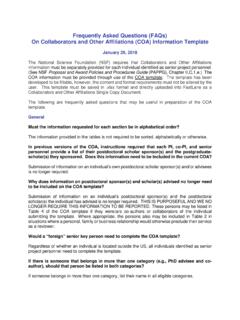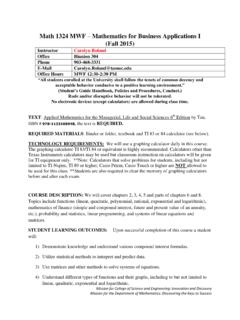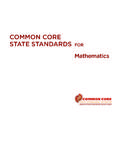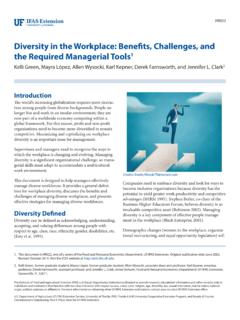Transcription of STEM - NSF - National Science Foundation
1 1 STEMSTEM3 STEM4 STEMSUBCOMMITTEE MEMBERSDr. Margaret Honey (Chair) | Dr. Bruce Alberts Dr. Hyman Bass | Dr. Carlos Castillo | Dr. Okhee Lee Dr. Marilyn M. Strutchens | Dr. Laurel Vermillion Dr. Francisco Rodriguez (Ex-Officio Member)NSF LIAISONDr. Robin Wright (Division Director, Undergraduate Education)EXECUTIVE SECRETARYDr. Alexandra Medina-Borja (NSF EHR/DUE)4 STEM5A VISION STATEMENT FOR STEM EDUCATION OF THE FUTURE All citizens can contribute to our nation s progress and vibrancy. To be prepared for the STEM careers of the future, all learners must have an equitable opportunity to acquire foundational STEM knowledge.
2 The STEM Education of the Future brings together our advanced understanding of how people learn with modern technology to create more personalized learning experiences, to inspire learning, and to foster creativity from an early age. It will unleash and harness the curiosity of young people and adult learners across the United States, cultivating a culture of innovation and inquiry, and ensuring our nation remains the global leader in Science and technology discovery and competitiveness. 67 PREFACE Rapid technological advancements and societal changes are our daily reality.
3 While the future of work, the economy, and society is uncertain, one thing is not: To maintain the nation s leadership in Science and technology discovery, we must create an approach to Science , technology, engineering , and math (STEM) education that prepares and advances the for this agree that Science , technology, engineering and math will drive new innovations across disciplines, making use of computational power to accelerate discoveries and finding creative ways to work across disciplinary silos to solve big challenges. To remain competitive going forward, our nation must continue to design and build a thriving innovation economy, supported by a citizenry that is invested in the STEM enterprise.
4 To succeed, the nation must invest in new research and innovation infrastructures that include all people, regardless of their DO WE ACHIEVE THIS VISION? We instill creativity, innovation, and a passion for STEM from an early age, and we maintain that engagement and enthusiasm throughout their lives. Doing so will unleash an innovation culture, teaching learners of all ages to take risks, be creative, and , we are far from this goal. Many Americans are entering the workforce without a basic grasp of STEM facts and approaches. Equally worrisome, amid the stagnant or dipping numbers of STEM workers, there is a critical lack of women, people with disabilities and African Americans, Hispanic Americans, and Native Americans who remain underrepresented in STEM.
5 This underrepresentation is especially evident in several strategic areas critical for progress and security, including computer Science , mathematics , and are in dire need of STEM role models and leaders for the future. By 2060,1 Black and Hispanic youth will comprise nearly half of all school-age children. However, STEM faculty from these backgrounds are currently scarce, and trends among the number of domestic students who pursue advanced research degrees in STEM disciplines particularly computer Science , mathematics , and engineering provide little hope for the necessary progress toward increasing diversity, inclusion, and equity of the STEM and STEM-education workforce representation gap is a threat, but it s also an opportunity for the American STEM education enterprise.
6 To maximize the opportunity, we must consider the entire education ecosystem so that children of all backgrounds, race, ethnicity, gender, religion and income levels can learn the wonders and possibilities of STEM and maintain that interest and passion throughout their lives. Whether or not they become scientists or engineers, all Americans should have the access, opportunity, encouragement, and tools to participate in the innovation economy, and to succeed amid technological progress and change. Likewise, it is vital to ensure that the American workforce is upskilled to thrive in a future influenced and transformed by technology.
7 PREFACE8 STEM9 Achieving the goals of lifelong STEM learning, equitable access to sustained success, and a strong American workforce will require answering key questions, including but not limited to: How can we incentivize higher education institutions to implement necessary change toward these goals, including adopting practices we know work? How can technology be used as a pedagogical tool and be a democratizing force? What non-traditional pathways are students taking to acquire skills, competencies, and credentials? How do these new pathways challenge higher education as we know it?
8 How do people best learn STEM concepts at different life stages? How do different contexts, including where people live, affect learning? And how do we optimize content delivery to improve outcomes?With these questions in mind, and with the goal that all Americans can become partners in the innovation economy, the STEM Education of the Future Subcommittee embarked on a journey2 to understand how others have answered similar questions, to better assess what is possible, and to set a clear path for making STEM Education of the Future the cornerstone of progress and prosperity for the nation.
9 PREFACE1011 PRIORITIES, CHALLENGES & ACTIONSB efore creating a vision for the STEM Education of the Future, it is vital to understand the present. What are the challenges we face in current STEM education? What is working, and where are we falling short? What are our priorities now, and how can we shape them to strengthen our future?STEMThe Subcommittee explored current examples of innovation in STEM Education, gathered information from individual experts and students, and looked for inspiration from NSF s 10 Big Ideas for Future In-vestment and the NSB s Vision 2030. From this work, the Subcommittee identified three priorities for a STEM Education of the Future that will ensure learners understand and are prepared for 21st century STEM knowledge and STEM careers: Priority One All learners at all stages of their educational pathways must have access to and opportunities to choose STEM careers and contribute to the innovation economy.
10 Priority Two We must build an ethical workforce with future-proof skills. Priority Three We must ensure that the appropriate technological innovations make it into learning spaces, whether face-to-face classrooms or not, guided by educators who understand how modern technology can affect learning, and how to use technology to enhance context and enrich learning experiences for STEM enterprise faces major challenges within each of these three priority areas. In this section, the Subcommittee identifies seven major challenges and provides action recommendations for how the STEM Education of the Future can address each of , CHALLENGES & ACTIONS1213 STEMPRIORITY IAll learners at all stages of their educational pathways must have access to and opportunities to choose STEM careers and contribute to the innovation 1 Access to high-quality STEM education is uneven across the nation s geography and institutions.



















